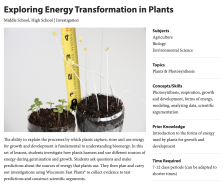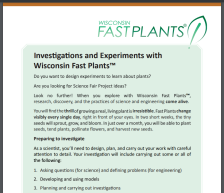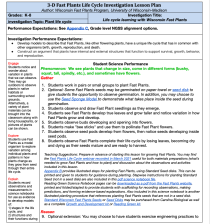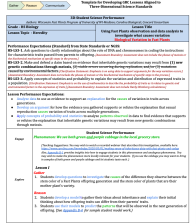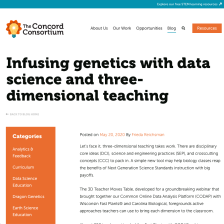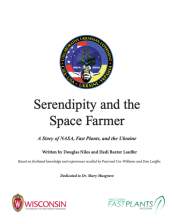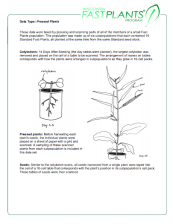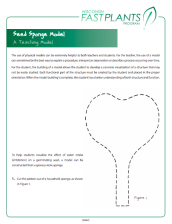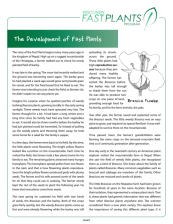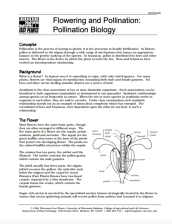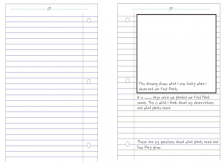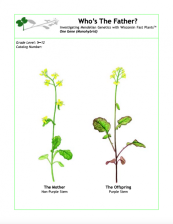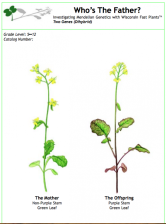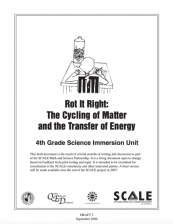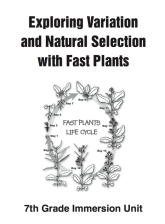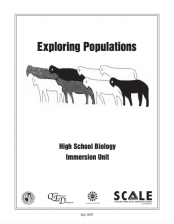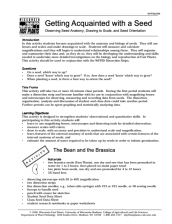Browse Resources
Resources | |
|---|---|
In this set of lessons and Fast Plants experiment, students investigate how plants harness and use different sources of energy during germination and growth. Students ask questions and make predictions about the sources of energy that plants use. They then plan and carry out investigations using...
This 5-page handout aims to help students and their adult mentors explore topics and questions about the natural world and/or Fast Plants growth and development that could be investigated through research and experimentation. The handout is intended to inspire scientific question development that...
This comprehensive Open Source lesson plan is designed for Kindergarten through Middle School level students to learn about life cycles, plants needs, and plant structures & their functions through hands-on investigations with Wisconsin Fast Plants. Depending on the grade level, students engage at...
In this 26-page investigation—co-developed for secondary grades by teachers, the Wisconsin Fast Plants Program at UW-Madison, The Concord Consortium data scientists, and developers from Carolina Biological Supply, and Brett Moulding—learners investigate variation and inheritance in the “three...
This blog post, written by Frieda Reichsman, discusses how educators can implement three-dimensional teaching methods into classrooms and meet the Next Generation Science Standards. The article introduces the 3D Teacher Moves Table, a lesson-planning tool created by Hedi Lauffer at Wisconsin Fast...
This resource, provided by Wisconsin Fast Plants and CurrikiStudio, contains a set of six different learning activities that can be implemented in classrooms to teach natural selection. Organized in playlists, these interactive lessons guide students through understanding and applying knowledge of...
Download this comprehensive, 60-page elementary unit that was co-developed by the Fast Plants Program and Emily Miller (ELA/science elementary science education specialist) who helped author the Next Generation Science Standards) as an exemplar for supporting three-dimensional learning. Developed in...
Who knew that rocket science could have so much in common with botany and plant pathology? This is a human interest and science story that documents from firsthand accounts and artifacts the historical context and scientific events relevant to an important collaborative Fast Plant investigation on...
These data sets were meticulously collected by Dr. Paul Williams in an investigation in which we were interested in learning about how nutrient limitations effect a variety of easily observable and measureable Fast Plant traits. Observations were made and recorded at different points in the plants'...
This 2-page handout gives instructions for making the seed sponge model that was developed by the Wisconsin Fast Plants Program as a tool for learning about germination. Visualizing what is inside a seed and how those structures function during germination is modeled, using a simple kitchen sponge....
Download this complete set of lessons for an elementary, NGSS-aligned inquiry that foregrounds engineering practices. During the days that are supported by this investigation, students observe flowers on their 14 to 16 day old Fast Plants along with bee structures, learning to connect how the shape...
This is "The Story of Fast Plants" - a short story of the origins of Brassicas and the work of Dr. Paul Williams, developing Brassica rapa. Reading level ~7th grade.
This Farming Fast Plants activity introduces a classroom investigation that is easily adaptable for all grade levels and designed to engage teachers and students as investigators. The activity has the practical outcome of producing an abundant supply of Fast Plants seed for future classroom use and...
This pdf includes background information and an activity for engaging students in the processes that occur during pollination, fertilization and seed development in Fast Plants. Pollination is explained and illustrated and an activity for students to pollinate Fast Plants and observe reproductive...
This document is the step-by-step instructions for planting Fast Plants in a deli-container growing system like is used in Reading Green. The instructions include measurements that are then integrated into mathematics problems that are on the flip side of the planting instructions. The instructions...
Download and print this colorful "Science Inquiry Map" Poster featuring the web of inquiry processes as described by the Five Essential Features of Inquiry from the National Science Education Standards. In addition, the model of inquiry described by the Five Essential Features aligns directly with...
In this investigation, students will gather their own evidence to explain how inheritance works. As they observe three generations of Wisconsin Fast Plants, students will unravel a mystery of paternity: What is the father’s phenotype? Is it the same as the mother’s phenotype or the offspring’s...
Download the complete instructions for a high school level inheritance and genetics inquiry, using Wisconsin Fast Plants. In this investigation, students gather their own evidence to explain how inheritance works. As they observe three generations of Wisconsin Fast Plants, students unravel a...
This Immersion Unit provides a coherent series of lessons designed to guide students in developing deep conceptual understanding that is aligned with the National standards, key science concepts, and essential features of classroom inquiry (as defined by the National Science Education Standards)....
Download this complete and coherently designed, middle school level unit to teach fundamental concepts that underpin the theory of evolution. The unit was collaboratively designed by teachers, college faculty & staff, and the Fast Plants Program at UW-Madison to support student-centered...
This Immersion Unit provides a coherent series of lessons designed to guide students in developing deep conceptual understanding that is aligned with the standards, key science concepts, and essential features of classroom inquiry (as defined by the National Science Education Standards).
Unit...
A 32-page booklet, containing complete instructions for activities at each life cycle stage. The booklet also includes important background information about plant physiology and how to grow Fast Plants. A Growth, Development and Reproduction kit is available. You can also conduct all the...
Description: In this activity students become acquainted with the anatomy and biology of seeds. They will use lenses and scales and make drawings to scale. Students will measure and calculate magnifications and they will begin to understand relationships among these. They will organize and summarize...
| |
